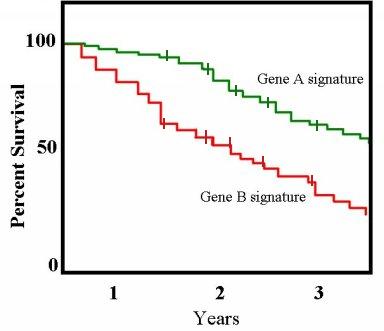
The Kaplan–Meier estimator, also known as the product limit estimator, is a
non-parametric statistic
A statistic (singular) or sample statistic is any quantity computed from values in a sample which is considered for a statistical purpose. Statistical purposes include estimating a population parameter, describing a sample, or evaluating a hypo ...
used to estimate the
survival function from lifetime data. In medical research, it is often used to measure the fraction of patients living for a certain amount of time after treatment. In other fields, Kaplan–Meier estimators may be used to measure the length of time people remain unemployed after a job loss, the time-to-failure of machine parts, or how long fleshy fruits remain on plants before they are removed by
frugivores. The
estimator is named after
Edward L. Kaplan and
Paul Meier, who each submitted similar manuscripts to the ''
Journal of the American Statistical Association''. The journal editor,
John Tukey, convinced them to combine their work into one paper, which has been cited almost 61,000 times since its publication in 1958.
The
estimator of the
survival function (the probability that life is longer than
) is given by:
:
with
a time when at least one event happened, ''d''
''i'' the ''number of events'' (e.g., deaths) that happened at time
, and
the ''individuals known to have survived'' (have not yet had an event or been censored) up to time
.
Basic concepts
A plot of the Kaplan–Meier estimator is a series of declining horizontal steps which, with a large enough sample size, approaches the true survival function for that population. The value of the survival function between successive distinct sampled observations ("clicks") is assumed to be constant.
An important advantage of the Kaplan–Meier curve is that the method can take into account some types of
censored data, particularly ''right-censoring'', which occurs if a patient withdraws from a study, is lost to follow-up, or is alive without event occurrence at last follow-up. On the plot, small vertical tick-marks state individual patients whose survival times have been right-censored. When no truncation or censoring occurs, the Kaplan–Meier curve is the
complement of the
empirical distribution function.
In
medical statistics, a typical application might involve grouping patients into categories, for instance, those with Gene A profile and those with Gene B profile. In the graph, patients with Gene B die much quicker than those with Gene A. After two years, about 80% of the Gene A patients survive, but less than half of patients with Gene B.
To generate a Kaplan–Meier estimator, at least two pieces of data are required for each patient (or each subject): the status at last observation (event occurrence or right-censored), and the time to event (or time to censoring). If the survival functions between two or more groups are to be compared, then a third piece of data is required: the group assignment of each subject.
Problem definition
Let
be a random variable, which we think of as the time until an event of interest takes place. As indicated above, the goal is to estimate the
survival function underlying
. Recall that this function is defined as
:
, where
is the time.
Let
be independent, identically distributed random variables, whose common distribution is that of
:
is the random time when some event
happened. The data available for estimating
is not
, but the list of pairs
where for
,
is a fixed, deterministic integer, the censoring time of event
and
. In particular, the information available about the timing of event
is whether the event happened before the fixed time
and if so, then the actual time of the event is also available. The challenge is to estimate
given this data.
Derivation of the Kaplan–Meier estimator
Here, we show two derivations of the Kaplan–Meier estimator. Both are based on rewriting the survival function in terms of what is sometimes called hazard, or mortality rates. However, before doing this it is worthwhile to consider a naive estimator.
A naive estimator
To understand the power of the Kaplan–Meier estimator, it is worthwhile to first describe a naive estimator of the survival function.
Fix
and let
. A basic argument shows that the following proposition holds:
:Proposition 1: If the censoring time
of event
exceeds
(
), then
if and only if
.
Let
be such that
. It follows from the above proposition that
:
Let
and consider only those
, i.e. the events for which the outcome was not censored before time
. Let
be the number of elements in
. Note that the set
is not random and so neither is
. Furthermore,
is a sequence of independent, identically distributed
Bernoulli random variables with common parameter
. Assuming that
, this suggests to estimate
using
:
where the second equality follows because
implies
, while the last equality is simply a change of notation.
The quality of this estimate is governed by the size of
. This can be problematic when
is small, which happens, by definition, when a lot of the events are censored. A particularly unpleasant property of this estimator, that suggests that perhaps it is not the "best" estimator, is that it ignores all the observations whose censoring time precedes
. Intuitively, these observations still contain information about
: For example, when for many events with
,
 The Kaplan–Meier estimator, also known as the product limit estimator, is a non-parametric
The Kaplan–Meier estimator, also known as the product limit estimator, is a non-parametric  The Kaplan–Meier estimator, also known as the product limit estimator, is a non-parametric
The Kaplan–Meier estimator, also known as the product limit estimator, is a non-parametric